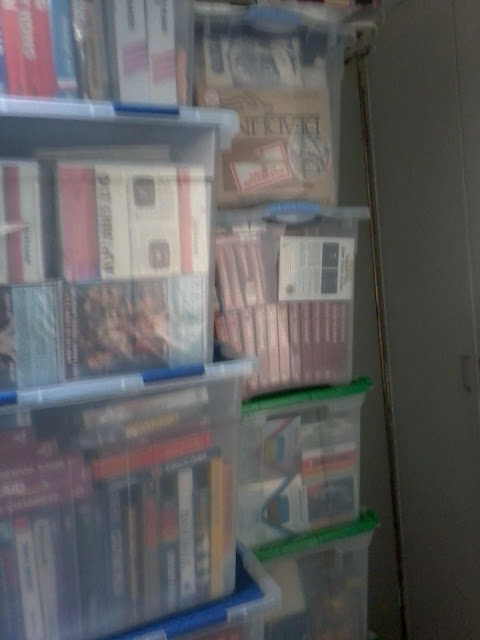Hola amigos, he conseguido un proveedor de juegos originales de 8 bit en venezuela, y quiero compartirlo con ustedes.
Al parecer, este personaje logro comprar como desechos de cartón unos 2000 juegos.
Repartidos mas o menos asi:
25% Atari consola (2600, 5200, etc)
25% Interlivisión
10% Atari computador 400, 800
10% Apple
10% Commodore 64, VIC 20
10% Coco, Mod I-III
10% Coleco, nintendo, consolitas de juegos y varias cosas mas pero en poca cantidad, mas que nada porque comenzó a comprar y vender coleccionables.
Hay muchos en cartucho, Discos y cassette.
Casi todo a unos 5-10 Dolares o 5 euros mas o menos al cambio a veces menos 2,50
El problema será enviaroslo.
Hay mucho de la empresa Microcomputer games
Compre varios, luego los detallare.
Todos a la venta. (Si los vendo todos ya que el proveedor tiene muchos iguales sellados)
1ra compra:
Nueva lista 60 juegos Juegos_8_Bits Excel
Todos estos juegos, excepto alguno que no quede mas, los podéis comprar, solo avisen y les ayudo
Perdón por las fotos de CEL algo borrosas
Algunas cajas con cajitas de juego.
Uno de los juegos
Revisando VOYAGER I - Sabotage of the Robot Ship (para COCO)
La caja:
Venia Un manual: Voyager I Manual, un cassette y registro (lo escanee pero para que ponerlo, Jeje)
Un Brochure o Folleto: Muy bonito:
No se lo pierdan
1Mb Microcomputer Games Brochure (optimized)
Full Jpg 27MB: Microcomputer_Games_Brochure
==================================================================================
Otros juegos que iré detallando:
Al parecer, este personaje logro comprar como desechos de cartón unos 2000 juegos.
Repartidos mas o menos asi:
25% Atari consola (2600, 5200, etc)
25% Interlivisión
10% Atari computador 400, 800
10% Apple
10% Commodore 64, VIC 20
10% Coco, Mod I-III
10% Coleco, nintendo, consolitas de juegos y varias cosas mas pero en poca cantidad, mas que nada porque comenzó a comprar y vender coleccionables.
Hay muchos en cartucho, Discos y cassette.
Casi todo a unos 5-10 Dolares o 5 euros mas o menos al cambio a veces menos 2,50
El problema será enviaroslo.
Hay mucho de la empresa Microcomputer games
Compre varios, luego los detallare.
Todos a la venta. (Si los vendo todos ya que el proveedor tiene muchos iguales sellados)
1ra compra:
NOMBRE | Empresa | MEDIO | |
ATLANTIS | ATARI 800 | IMAGIC | CARTRIDGE |
B.C.'S QUEST FOR TIRES | ATARI 800 | SIERRA | CARTRIDGE |
CENTEPIDE | ATARI 800 | Atari Soft | CARTRIDGE |
DEMON ATACK | ATARI 800 | IMAGIC | CARTRIDGE |
FROGGER | ATARI 800 | Parker Broters (Sega) | CARTRIDGE |
POLE POSITION | ATARI 800 | ATARI | CARTRIDGE |
Q*BERT | ATARI 800 | Parker Broters | CARTRIDGE |
APPLE PANIC | ATARI 800 | Bronderbund Software | CASSETTE |
TECLADO | ATARI Original | Stectravideo Compumate | TECLADO |
BUCK ROGERS | COMMODORE 64 | SEGA | CARTRIDGE |
CENTEPIDE | COMMODORE 64 | Atari Soft | CARTRIDGE |
CLOWNS | COMMODORE 64 | Bally/MIDWAY | CARTRIDGE |
DIG BUG | COMMODORE 64 | Atari Soft | CARTRIDGE |
DONKEY KONG | COMMODORE 64 | Atari Soft | CARTRIDGE |
GRIDRUNNER | COMMODORE 64 | HesWare | CARTRIDGE |
PAC-MAN | COMMODORE 64 | Atari Soft | CARTRIDGE |
Star programing GORTEK AND THE MICROCHIPS | COMMODORE 64 | COMMODORE businness machinnes, inc. | CASSETTE |
BANDITS | COMMODORE 64 | Sirius | DISK |
RENDEZVOUS WIITH RAMA (Artur C. Clark) | COMMODORE 64 | TRILIUM | Disk |
The Pharaon`s Curse | COMMODORE 64 | Synapse Software | DISK |
GAME GENIE | Super Nintendo | Galoob | CARTRIDGE |
BREAKTHRU | TRS-80 COLOR COMPUTER - TDP S-100, 16K | Sports Illustarted | CASSETTE |
VOYAGER I - Sabotage of the Robot Ship | TRS-80 Model I&III, 16K - Color 16K - APPLE II+, 32K - ATARI 4/800, 32K - PET CBM, 32K | Microcomputer games | CASSETTE |
EMPIRE OF THE OVERMIND | TRS-80 Model I/III, 48K APPLE II, II+, IIe, 48K - ATARI 800, 1200, 40K | CASSETTE |
Nueva lista 60 juegos Juegos_8_Bits Excel
Todos estos juegos, excepto alguno que no quede mas, los podéis comprar, solo avisen y les ayudo
Perdón por las fotos de CEL algo borrosas
Algunas cajas con cajitas de juego.
Uno de los juegos
Revisando VOYAGER I - Sabotage of the Robot Ship (para COCO)
La caja:
Venia Un manual: Voyager I Manual, un cassette y registro (lo escanee pero para que ponerlo, Jeje)
Un Brochure o Folleto: Muy bonito:
No se lo pierdan
1Mb Microcomputer Games Brochure (optimized)
Full Jpg 27MB: Microcomputer_Games_Brochure
==================================================================================
Otros juegos que iré detallando:







